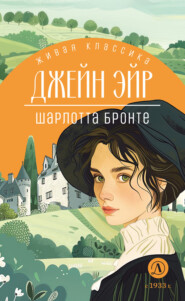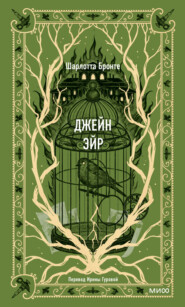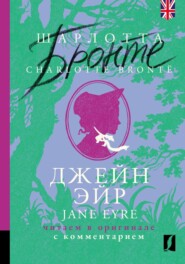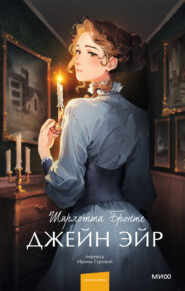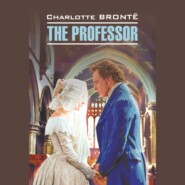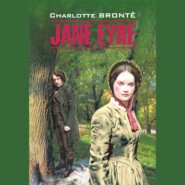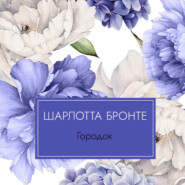По всем вопросам обращайтесь на: info@litportal.ru
(©) 2003-2024.
✖
Jane Eyre
Автор
Год написания книги
2019
Настройки чтения
Размер шрифта
Высота строк
Поля
Jane Eyre
Charlotte Bronte
HarperCollins is proud to present a range of best-loved, essential classics.'I am no bird; and no net ensnares me; I am a free human being with an independent will.'Bronte's infamous Gothic novel tells the story of orphan Jane, a child of unfortunate circumstances. Raised and treated badly by her aunt and cousins and eventually sent away to a cruel boarding school, it is not until Jane becomes a governess at Thornfield that she finds happiness. Meek, measured, but determined, Jane soon falls in love with her brooding and stormy master, Mr Rochester, but it is not long before strange and unnerving events occur in the house and Jane is forced to leave Thornfield to pursue her future.
History of Collins (#ulink_5f3a5ad6-f02c-5621-91ec-0685fca78403)
In 1819, Millworker William Collins from Glasgow, Scotland, set up a company for printing and publishing pamphlets, sermons, hymn books and prayer books. That company was Collins and was to mark the birth of HarperCollins Publishers as we know it today. The long tradition of Collins dictionary publishing can be traced back to the first dictionary William published in 1824, Greek and English Lexicon. Indeed, from 1840 onwards, he began to produce illustrated dictionaries and even obtained a licence to print and publish the Bible.
Soon after, William published the first Collins novel, Ready Reckoner, however it was the time of the Long Depression, where harvests were poor, prices were high, potato crops had failed and violence was erupting in Europe. As a result, many factories across the country were forced to close down and William chose to retire in 1846, partly due to the hardships he was facing.
Aged 30, William’s son, William II took over the business. A keen humanitarian with a warm heart and a generous spirit, William II was truly ‘Victorian’ in his outlook. He introduced new, up-to-date steam presses and published affordable editions of Shakespeare’s works and Pilgrim’s Progress, making them available to the masses for the first time. A new demand for educational books meant that success came with the publication of travel books, scientific books, encyclopaedias and dictionaries. This demand to be educated led to the later publication of atlases and Collins also held the monopoly on scripture writing at the time.
In the 1860s Collins began to expand and diversify and the idea of ‘books for the millions’ was developed. Affordable editions of classical literature were published and in 1903 Collins introduced 10 titles in their Collins Handy Illustrated Pocket Novels. These proved so popular that a few years later this had increased to an output of 50 volumes, selling nearly half a million in their year of publication. In the same year, The Everyman’s Library was also instituted, with the idea of publishing an affordable library of the most important classical works, biographies, religious and philosophical treatments, plays, poems, travel and adventure. This series eclipsed all competition at the time and the introduction of paperback books in the 1950s helped to open that market and marked a high point in the industry.
HarperCollins is and has always been a champion of the classics and the current Collins Classics series follows in this tradition – publishing classical literature that is affordable and available to all. Beautifully packaged, highly collectible and intended to be reread and enjoyed at every opportunity.
Life & Times (#ulink_0182f0c2-260c-5524-bb6b-4c42328b6d80)
The Brontë Family
Following in the footsteps of Jane Austen, The Brontë sisters, Charlotte, Emily and Anne, were the next generation of female writers. Unlike Austen, they were northerners, born and raised in West Yorkshire, England. There were also two other sisters, Maria and Elizabeth, who sadly died young from tuberculosis, and a brother, Branwell, who became an artist and poet, fuelled by his opium and alcohol addiction.
Charlotte Brontë (1816—55) had three novels published in her lifetime, but it is for Jane Eyre (1847) that she is most celebrated. Her sister, Emily Brontë (1818—48) is lauded for her only novel Wuthering Heights (1847) – a complex tragedy, spanning two generations that expresses the mess people can make of their lives when needs and desires are allowed to control their actions and reactions, as opposed to common sense and restraint.
Anne Brontë (1820-49) is the lesser known of the sisters. She published two novels, Agnes Grey (1847) and the Tennant of Wildfell Hall (1848). Unlike her sisters, Anne’s style was one of realism rather than romanticism, making her the more contemporary writer at the time.
All three sisters used pen names, Currer Bell, Ellis Bell and Acton Bell respectively, as it was quite usual at that time for female novelists to adopt male pseudonyms in an effort to be taken more seriously. Indeed, another well-known female author, George Eliot (1818—80), had the real name Mary Ann Evans. The reputation of the female novelist at the time was uncertain and it seems that Jane Austen herself may have prompted this practice.
The surname Brontë wasn’t wholly genuine either. Their father, Patrick, had originally been known as ‘Brunty’, a name he claimed, it is widely thought, for reasons of insecurity and vanity. An unusual name gave the illusion of continental sophistication and heritage, in much the same way that some people today settle on double-barrelled surnames to align themselves with the aristocracy.
Unfortunately for the Brontë sisters, they were all rather shortlived. Two years following the death of Charlotte, her friend and fellow novelist Elizabeth Gaskell published a biography of the elder Brontë. Gaskell’s biography created the impression of a family beset by misfortune, which was to all intents and purposes rather true, as their mother, Maria, had passed away in 1821 and even Branwell had died in 1848. Patrick outlived his entire family, dying at the impressive age of 84, in 1861.
Charlotte Brontë
As a focussed woman, with a great deal of determination, Charlotte originally wrote in order to secure financial independence for herself and her siblings. She spent periods of time away from her family home, at boarding school in her youth, and later on as a governess, giving her invaluable experiences to draw upon for her best known novels. Following the death of Anne from pulmonary tuberculosis in 1849, Charlotte’s success with the publication of Jayne Eyre prompted her to reveal her true identity and real name. She frequently travelled to London and became acquainted with a number of prominent figures of the age. Her book was seen as a seminal work, introducing the idea that women could achieve their desires by demonstrating strength of character. In 1854, Charlotte was married to her father’s curate, Arthur Bell Nicholls. She became pregnant, but fell ill and died with child.
Common Themes
Today, the novels of the Brontë sisters are as much a part of English literary history as the works of any other. There is a singularity about their collective way of viewing the world that speaks volumes about the relative isolation they experienced during their upbringing. Their father was a bookish and scholarly man who, by his very nature, was not given to worrying about the effects of solitude on his children. The result was that his children grew to be quite introverted, which was probably why they found company in each other and in their imaginations. It was considered highly unusual then, as it would be now, for three sisters to devote their lives to writing novels.
Like Jane Austen, before them, they existed on the fringes of polite society, where they could observe people and capture their personalities in prose, but were not necessarily thought of as eligible for marriage or inclusion in certain social circles. That marginaliza-tion, in itself, gave rise to frustrations, desires and needs that must have fuelled their creative drive. Their novels act as vehicles for self expression, alluding to their misgivings about life and providing them with strong voices for the plight of females in the 19th century.
The Brontë Legacy
For the three sisters, Charlotte, Emily and Anne, writing was clearly a way of living vicariously. Their social environment, their milieu, was such that they had rather limited experience of the outside world. Fragile health characterized the family, so that their mother and two other sisters had already died of illness by the time the three were teenagers. Their father was a teacher and clergyman, who kept a tight rein on his daughters and one son, for fear of losing them also. Tragically, he did lose them all before any had reached the age of 40, but not before his three daughters had tasted success as published novelists.
Their styles as novelists were quite individual, but there is a detectable thread of commonality in them, in the sense that the sisters were using prose as a means of communicating with the world beyond the sanctuary of home. They were well educated intellectuals, though with relatively little by way of fiscal wealth and somewhat reserved in nature. This made them well suited to writing, but unattractive as potential spouses for most eligible young men.
Charlotte and Emily used their novels to effectively live other lives, and they are often described as romanticists as a result. Anne did the same, but in a less imaginative frame, so that her scenarios were not too far removed from reality. The year 1847 was the most eventful period of time for the Brontë sisters, as it saw all three of their aforementioned novels published – Jane Eyre, Wuthering Heights and Agnes Grey.
The fictitious character Jane Eyre, of the eponymous novel, could easily be translated as Charlotte imagining herself in a scenario where she comes from a background far worse than her own, but ends up living a life that is more rounded and fulfilled than the one she leads, reinventing herself in prose.
Emily goes even further than Charlotte with Wuthering Heights. She imagines different versions of herself living through an epic story of tragedy. She must have longed for more adventure and excitement in her life, and therefore acted it out in the theatre of her imagination.
In Anne’s Agnes Grey there is obvious overlap between Anne and Agnes, so that a blend of fact and fiction is evident. Ann was more concerned with using her prose to express the real trials and tribulations of her life as a governess, as opposed to using them as a form of escapism, like her sisters.
In a way the cumulative result of the Brontë’s work is to demonstrate three depths to which fictional prose can be used as a form of self expression. All three sisters transposed themselves into their imagined worlds, but to differing extremes from Anne to Charlotte to Emily. This might be interpreted as an indication of their different personality types, but as they all lived very short lives it is impossible to know how their individual preferences might have adapted and matured over time.
The social impact and legacy of the Brontës work was that it dared to be truthful and self indulgent in an age when polite society was reserved and reticent about emotions and desires. While Jane Austen’s work had described the lives of people somewhat removed from an environment most people would consider familiar, the Brontës described the lives of people who were more human, in that they were not nearly so bound by rules of etiquette and prescribed ways of behaving. It wasn’t necessary to read between the lines to understand the allegory, because the Brontës wrote from the heart in an exposing and honest way that was so new that it heightened people’s idea of the very purpose of literature as an art form.
Jane Eyre
Table of Contents
Cover Page (#u0567c9a6-f505-5278-be56-0078cc2092bd)
History of Collins (#u0c7b4893-d456-5889-b037-e4dba6a6e5e0)
Life & Times (#u38fd8d0e-bafd-5443-8d5b-9d70c04cd84e)
Title Page (#u5bc5f3e9-9527-5536-8f11-3378b6b42357)
PREFACE (#u00214111-fc51-5c59-8695-c751ab7972bf)
CHAPTER 1 (#uf04c24f6-6ccb-5956-be29-e33be94cb9d6)
CHAPTER 2 (#u82a34592-d35e-5476-8f32-e2a3b087224c)
CHAPTER 3 (#ud84381fa-2a8b-56ad-935d-935d5c16d01e)
CHAPTER 4 (#ub2983d49-afe9-5b72-8a6b-0cea473edd44)
CHAPTER 5 (#u1b99d3a8-af99-5ad5-9f3b-faacd1149176)
CHAPTER 6 (#u05f3a51b-2038-514b-ae63-e6b3daa33dfa)
CHAPTER 7 (#ub7e83b7b-c31f-5345-a42e-c03860c6c398)
CHAPTER 8 (#uec7a0724-b6d1-5887-949f-30658b889208)
CHAPTER 9 (#u0ab4f553-316a-5570-bd81-8d8e25e1b50c)
CHAPTER 10 (#u1e969422-af2e-5ced-9cbc-3224152c19ee)
CHAPTER 11 (#ue13932dd-0b65-5723-97cd-aa638f8376f7)
CHAPTER 12 (#u333bddf5-b80b-5fc5-a64c-a7d4a6200f5c)
CHAPTER 13 (#litres_trial_promo)
Charlotte Bronte
HarperCollins is proud to present a range of best-loved, essential classics.'I am no bird; and no net ensnares me; I am a free human being with an independent will.'Bronte's infamous Gothic novel tells the story of orphan Jane, a child of unfortunate circumstances. Raised and treated badly by her aunt and cousins and eventually sent away to a cruel boarding school, it is not until Jane becomes a governess at Thornfield that she finds happiness. Meek, measured, but determined, Jane soon falls in love with her brooding and stormy master, Mr Rochester, but it is not long before strange and unnerving events occur in the house and Jane is forced to leave Thornfield to pursue her future.
History of Collins (#ulink_5f3a5ad6-f02c-5621-91ec-0685fca78403)
In 1819, Millworker William Collins from Glasgow, Scotland, set up a company for printing and publishing pamphlets, sermons, hymn books and prayer books. That company was Collins and was to mark the birth of HarperCollins Publishers as we know it today. The long tradition of Collins dictionary publishing can be traced back to the first dictionary William published in 1824, Greek and English Lexicon. Indeed, from 1840 onwards, he began to produce illustrated dictionaries and even obtained a licence to print and publish the Bible.
Soon after, William published the first Collins novel, Ready Reckoner, however it was the time of the Long Depression, where harvests were poor, prices were high, potato crops had failed and violence was erupting in Europe. As a result, many factories across the country were forced to close down and William chose to retire in 1846, partly due to the hardships he was facing.
Aged 30, William’s son, William II took over the business. A keen humanitarian with a warm heart and a generous spirit, William II was truly ‘Victorian’ in his outlook. He introduced new, up-to-date steam presses and published affordable editions of Shakespeare’s works and Pilgrim’s Progress, making them available to the masses for the first time. A new demand for educational books meant that success came with the publication of travel books, scientific books, encyclopaedias and dictionaries. This demand to be educated led to the later publication of atlases and Collins also held the monopoly on scripture writing at the time.
In the 1860s Collins began to expand and diversify and the idea of ‘books for the millions’ was developed. Affordable editions of classical literature were published and in 1903 Collins introduced 10 titles in their Collins Handy Illustrated Pocket Novels. These proved so popular that a few years later this had increased to an output of 50 volumes, selling nearly half a million in their year of publication. In the same year, The Everyman’s Library was also instituted, with the idea of publishing an affordable library of the most important classical works, biographies, religious and philosophical treatments, plays, poems, travel and adventure. This series eclipsed all competition at the time and the introduction of paperback books in the 1950s helped to open that market and marked a high point in the industry.
HarperCollins is and has always been a champion of the classics and the current Collins Classics series follows in this tradition – publishing classical literature that is affordable and available to all. Beautifully packaged, highly collectible and intended to be reread and enjoyed at every opportunity.
Life & Times (#ulink_0182f0c2-260c-5524-bb6b-4c42328b6d80)
The Brontë Family
Following in the footsteps of Jane Austen, The Brontë sisters, Charlotte, Emily and Anne, were the next generation of female writers. Unlike Austen, they were northerners, born and raised in West Yorkshire, England. There were also two other sisters, Maria and Elizabeth, who sadly died young from tuberculosis, and a brother, Branwell, who became an artist and poet, fuelled by his opium and alcohol addiction.
Charlotte Brontë (1816—55) had three novels published in her lifetime, but it is for Jane Eyre (1847) that she is most celebrated. Her sister, Emily Brontë (1818—48) is lauded for her only novel Wuthering Heights (1847) – a complex tragedy, spanning two generations that expresses the mess people can make of their lives when needs and desires are allowed to control their actions and reactions, as opposed to common sense and restraint.
Anne Brontë (1820-49) is the lesser known of the sisters. She published two novels, Agnes Grey (1847) and the Tennant of Wildfell Hall (1848). Unlike her sisters, Anne’s style was one of realism rather than romanticism, making her the more contemporary writer at the time.
All three sisters used pen names, Currer Bell, Ellis Bell and Acton Bell respectively, as it was quite usual at that time for female novelists to adopt male pseudonyms in an effort to be taken more seriously. Indeed, another well-known female author, George Eliot (1818—80), had the real name Mary Ann Evans. The reputation of the female novelist at the time was uncertain and it seems that Jane Austen herself may have prompted this practice.
The surname Brontë wasn’t wholly genuine either. Their father, Patrick, had originally been known as ‘Brunty’, a name he claimed, it is widely thought, for reasons of insecurity and vanity. An unusual name gave the illusion of continental sophistication and heritage, in much the same way that some people today settle on double-barrelled surnames to align themselves with the aristocracy.
Unfortunately for the Brontë sisters, they were all rather shortlived. Two years following the death of Charlotte, her friend and fellow novelist Elizabeth Gaskell published a biography of the elder Brontë. Gaskell’s biography created the impression of a family beset by misfortune, which was to all intents and purposes rather true, as their mother, Maria, had passed away in 1821 and even Branwell had died in 1848. Patrick outlived his entire family, dying at the impressive age of 84, in 1861.
Charlotte Brontë
As a focussed woman, with a great deal of determination, Charlotte originally wrote in order to secure financial independence for herself and her siblings. She spent periods of time away from her family home, at boarding school in her youth, and later on as a governess, giving her invaluable experiences to draw upon for her best known novels. Following the death of Anne from pulmonary tuberculosis in 1849, Charlotte’s success with the publication of Jayne Eyre prompted her to reveal her true identity and real name. She frequently travelled to London and became acquainted with a number of prominent figures of the age. Her book was seen as a seminal work, introducing the idea that women could achieve their desires by demonstrating strength of character. In 1854, Charlotte was married to her father’s curate, Arthur Bell Nicholls. She became pregnant, but fell ill and died with child.
Common Themes
Today, the novels of the Brontë sisters are as much a part of English literary history as the works of any other. There is a singularity about their collective way of viewing the world that speaks volumes about the relative isolation they experienced during their upbringing. Their father was a bookish and scholarly man who, by his very nature, was not given to worrying about the effects of solitude on his children. The result was that his children grew to be quite introverted, which was probably why they found company in each other and in their imaginations. It was considered highly unusual then, as it would be now, for three sisters to devote their lives to writing novels.
Like Jane Austen, before them, they existed on the fringes of polite society, where they could observe people and capture their personalities in prose, but were not necessarily thought of as eligible for marriage or inclusion in certain social circles. That marginaliza-tion, in itself, gave rise to frustrations, desires and needs that must have fuelled their creative drive. Their novels act as vehicles for self expression, alluding to their misgivings about life and providing them with strong voices for the plight of females in the 19th century.
The Brontë Legacy
For the three sisters, Charlotte, Emily and Anne, writing was clearly a way of living vicariously. Their social environment, their milieu, was such that they had rather limited experience of the outside world. Fragile health characterized the family, so that their mother and two other sisters had already died of illness by the time the three were teenagers. Their father was a teacher and clergyman, who kept a tight rein on his daughters and one son, for fear of losing them also. Tragically, he did lose them all before any had reached the age of 40, but not before his three daughters had tasted success as published novelists.
Their styles as novelists were quite individual, but there is a detectable thread of commonality in them, in the sense that the sisters were using prose as a means of communicating with the world beyond the sanctuary of home. They were well educated intellectuals, though with relatively little by way of fiscal wealth and somewhat reserved in nature. This made them well suited to writing, but unattractive as potential spouses for most eligible young men.
Charlotte and Emily used their novels to effectively live other lives, and they are often described as romanticists as a result. Anne did the same, but in a less imaginative frame, so that her scenarios were not too far removed from reality. The year 1847 was the most eventful period of time for the Brontë sisters, as it saw all three of their aforementioned novels published – Jane Eyre, Wuthering Heights and Agnes Grey.
The fictitious character Jane Eyre, of the eponymous novel, could easily be translated as Charlotte imagining herself in a scenario where she comes from a background far worse than her own, but ends up living a life that is more rounded and fulfilled than the one she leads, reinventing herself in prose.
Emily goes even further than Charlotte with Wuthering Heights. She imagines different versions of herself living through an epic story of tragedy. She must have longed for more adventure and excitement in her life, and therefore acted it out in the theatre of her imagination.
In Anne’s Agnes Grey there is obvious overlap between Anne and Agnes, so that a blend of fact and fiction is evident. Ann was more concerned with using her prose to express the real trials and tribulations of her life as a governess, as opposed to using them as a form of escapism, like her sisters.
In a way the cumulative result of the Brontë’s work is to demonstrate three depths to which fictional prose can be used as a form of self expression. All three sisters transposed themselves into their imagined worlds, but to differing extremes from Anne to Charlotte to Emily. This might be interpreted as an indication of their different personality types, but as they all lived very short lives it is impossible to know how their individual preferences might have adapted and matured over time.
The social impact and legacy of the Brontës work was that it dared to be truthful and self indulgent in an age when polite society was reserved and reticent about emotions and desires. While Jane Austen’s work had described the lives of people somewhat removed from an environment most people would consider familiar, the Brontës described the lives of people who were more human, in that they were not nearly so bound by rules of etiquette and prescribed ways of behaving. It wasn’t necessary to read between the lines to understand the allegory, because the Brontës wrote from the heart in an exposing and honest way that was so new that it heightened people’s idea of the very purpose of literature as an art form.
Jane Eyre
Table of Contents
Cover Page (#u0567c9a6-f505-5278-be56-0078cc2092bd)
History of Collins (#u0c7b4893-d456-5889-b037-e4dba6a6e5e0)
Life & Times (#u38fd8d0e-bafd-5443-8d5b-9d70c04cd84e)
Title Page (#u5bc5f3e9-9527-5536-8f11-3378b6b42357)
PREFACE (#u00214111-fc51-5c59-8695-c751ab7972bf)
CHAPTER 1 (#uf04c24f6-6ccb-5956-be29-e33be94cb9d6)
CHAPTER 2 (#u82a34592-d35e-5476-8f32-e2a3b087224c)
CHAPTER 3 (#ud84381fa-2a8b-56ad-935d-935d5c16d01e)
CHAPTER 4 (#ub2983d49-afe9-5b72-8a6b-0cea473edd44)
CHAPTER 5 (#u1b99d3a8-af99-5ad5-9f3b-faacd1149176)
CHAPTER 6 (#u05f3a51b-2038-514b-ae63-e6b3daa33dfa)
CHAPTER 7 (#ub7e83b7b-c31f-5345-a42e-c03860c6c398)
CHAPTER 8 (#uec7a0724-b6d1-5887-949f-30658b889208)
CHAPTER 9 (#u0ab4f553-316a-5570-bd81-8d8e25e1b50c)
CHAPTER 10 (#u1e969422-af2e-5ced-9cbc-3224152c19ee)
CHAPTER 11 (#ue13932dd-0b65-5723-97cd-aa638f8376f7)
CHAPTER 12 (#u333bddf5-b80b-5fc5-a64c-a7d4a6200f5c)
CHAPTER 13 (#litres_trial_promo)






